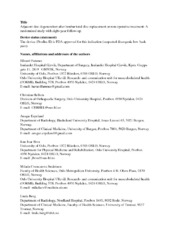Adjacent Disc Degeneration After Lumbar Total Disc Replacement or Non-operative Treatment: A Randomized Study With Eight-year Follow-up
Furunes, Håvard; Hellum, Christian; Espeland, Ansgar; Brox, Jens Ivar; Småstuen, Milada C; Berg, Linda; Storheim, Kjersti
Peer reviewed, Journal article
Accepted version
Permanent lenke
https://hdl.handle.net/1956/19872Utgivelsesdato
2018-12Metadata
Vis full innførselSamlinger
Sammendrag
Study Design. A randomized controlled multicenter trial with 8-year follow-up. Objective. The aim of this study was to assess the long-term development of adjacent disc degeneration (ADD) after lumbar total disc replacement (TDR) or nonoperative treatment, and to analyze the association between ADD development and clinical outcome. Summary of Background Data. TDR was introduced as a motion-preserving alternative to spinal fusion, which has been reported to increase the risk of ADD. However, ADD may develop naturally regardless of any surgery, and no randomized study has assessed the long-term development of ADD after TDR versus nonoperative treatment. Methods. The study included 126 of the 173 patients with chronic low back pain (LBP) originally included in a randomized study comparing TDR with multidisciplinary rehabilitation. Magnetic resonance imaging (MRI) of the lumbar spine was performed before treatment and at 8-year follow-up. ADD was categorized as increased or not increased based on an evaluation of Modic changes, disc height reduction, disc contour, herniation size, nucleus pulposus signal, and posterior high intensity zones. We used a χ2 test or a Fisher exact test to compare crude proportions, and multiple linear regressions to analyze the association between increased ADD (yes/no) and change in Oswestry Disability Index (ODI) from pre-treatment to follow-up. Results. ADD increased (for at least one ADD variable) in 23 of 57 patients (40%) treated nonoperatively, and 29 of 69 patients (42%) treated with TDR (P = 0.86). We found no significant associations between ADD increase and the change in ODI. Conclusion. Increased ADD occurred with similar frequency after TDR and after nonoperative treatment, and was not related to the clinical outcome at 8-year follow-up.
